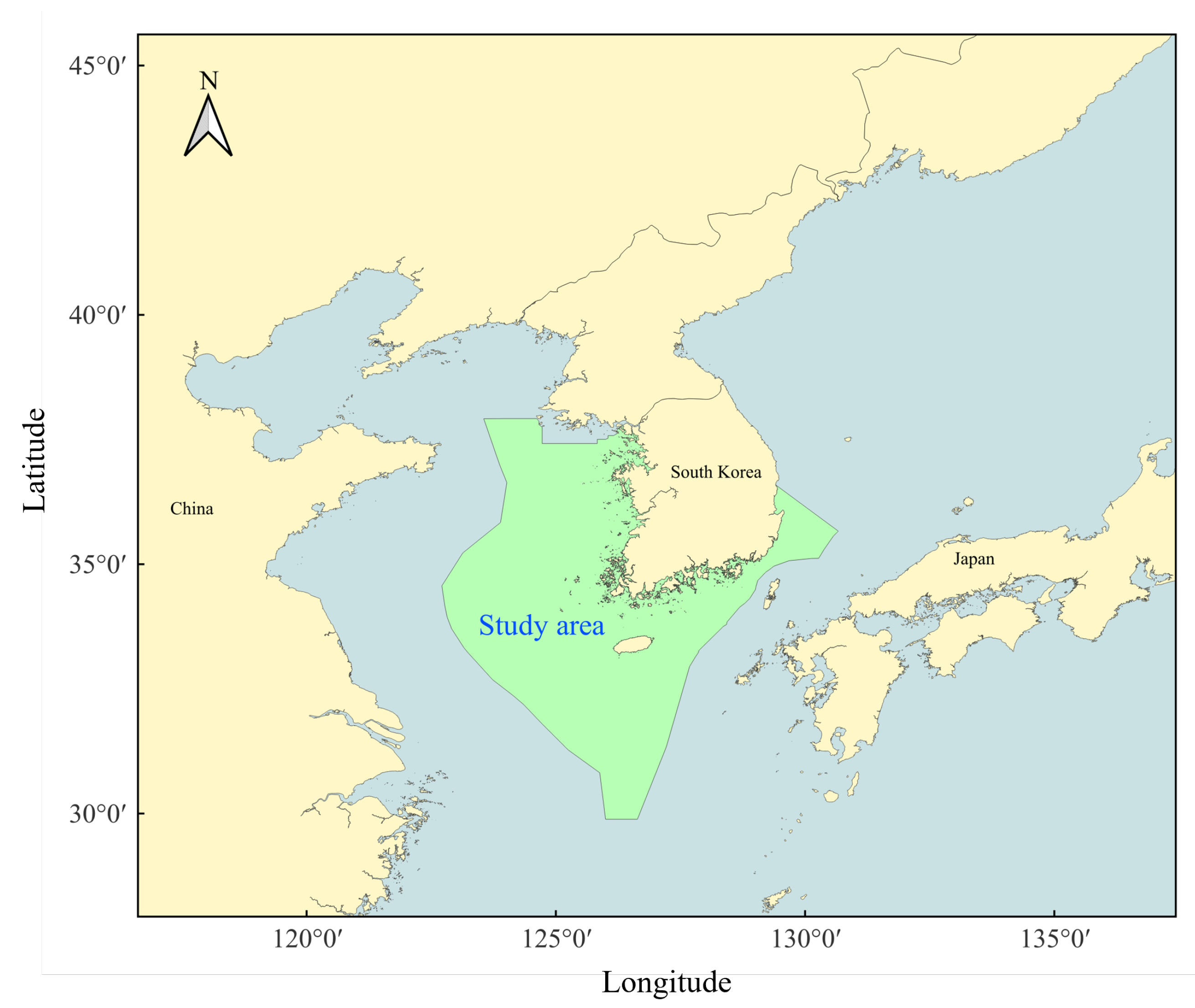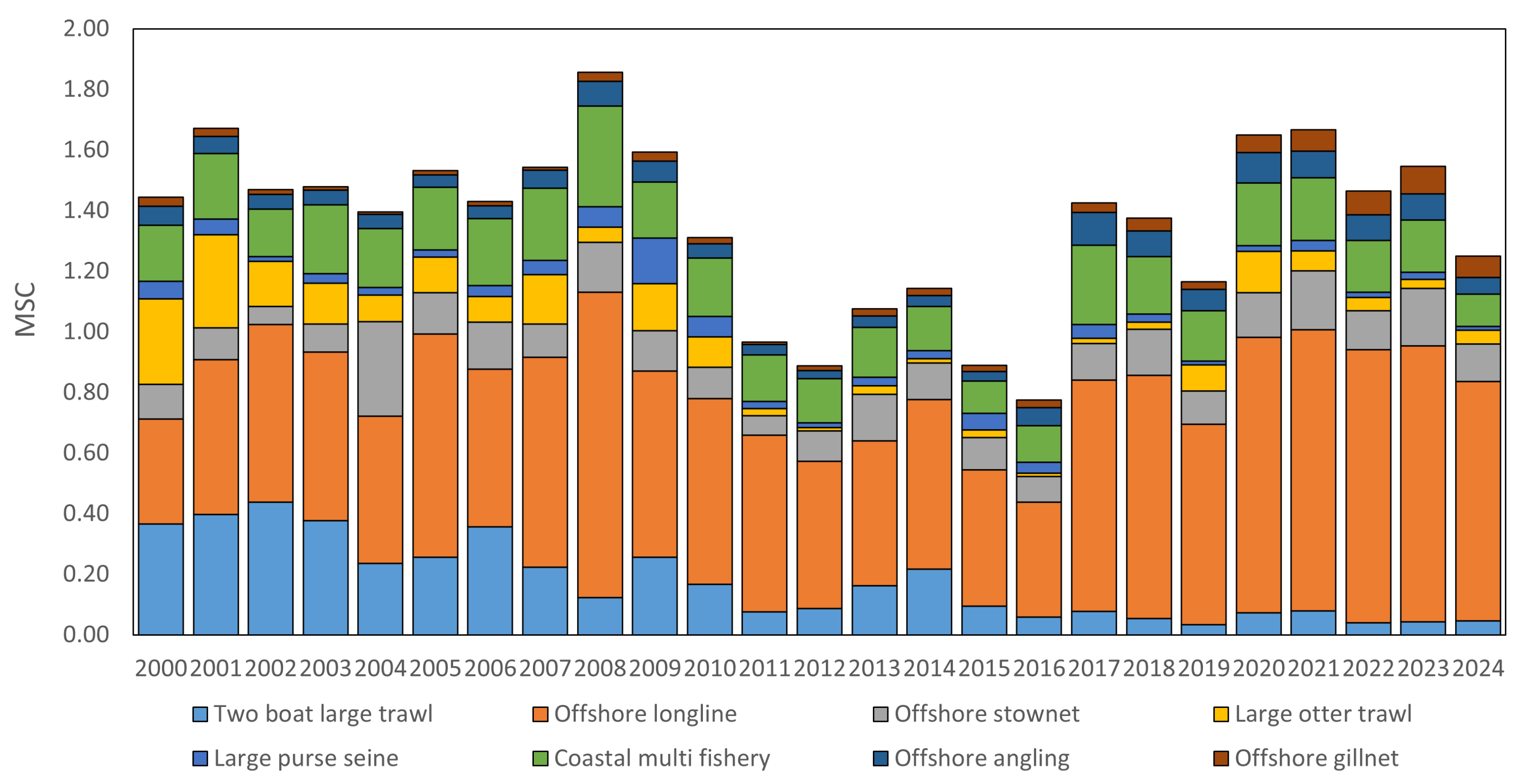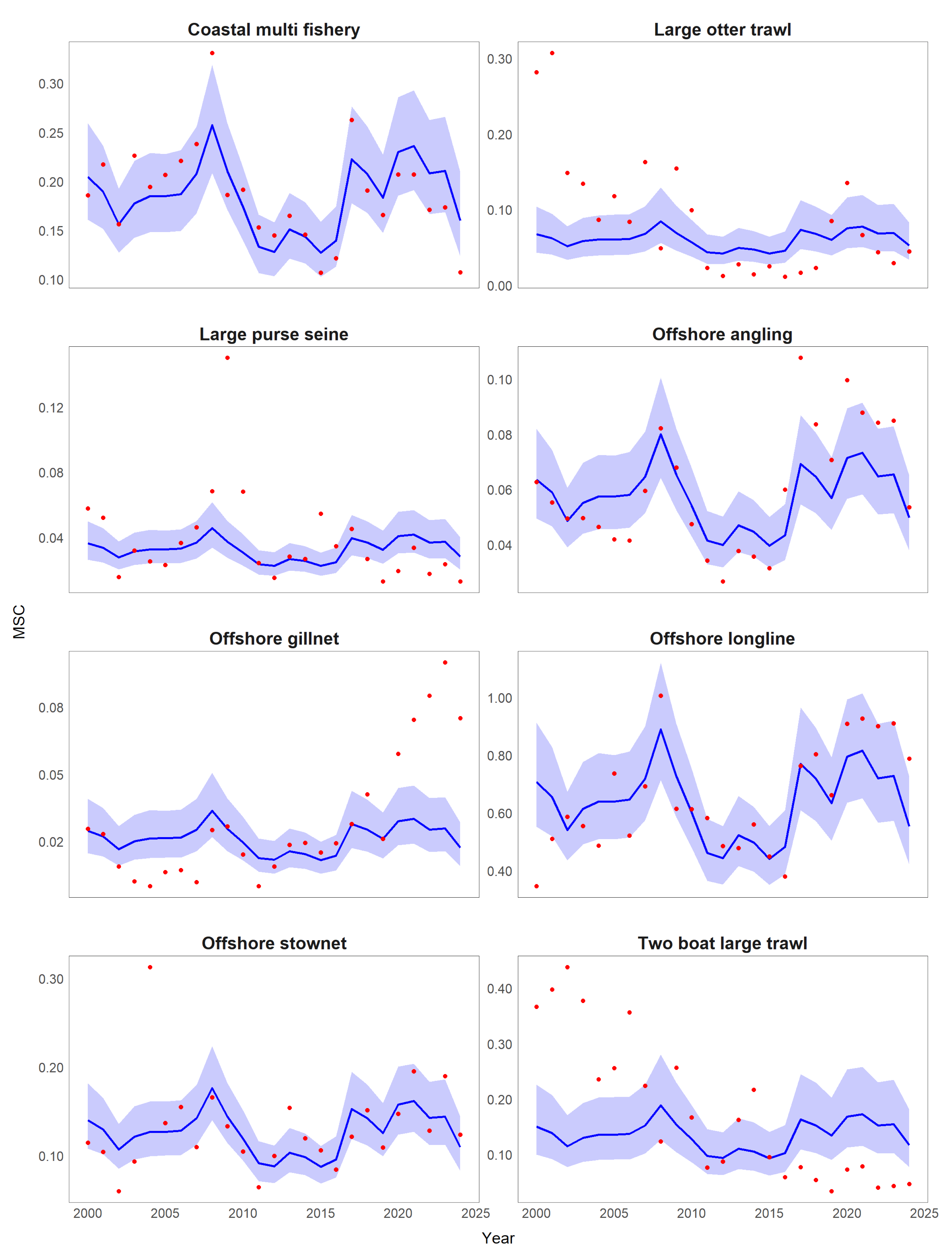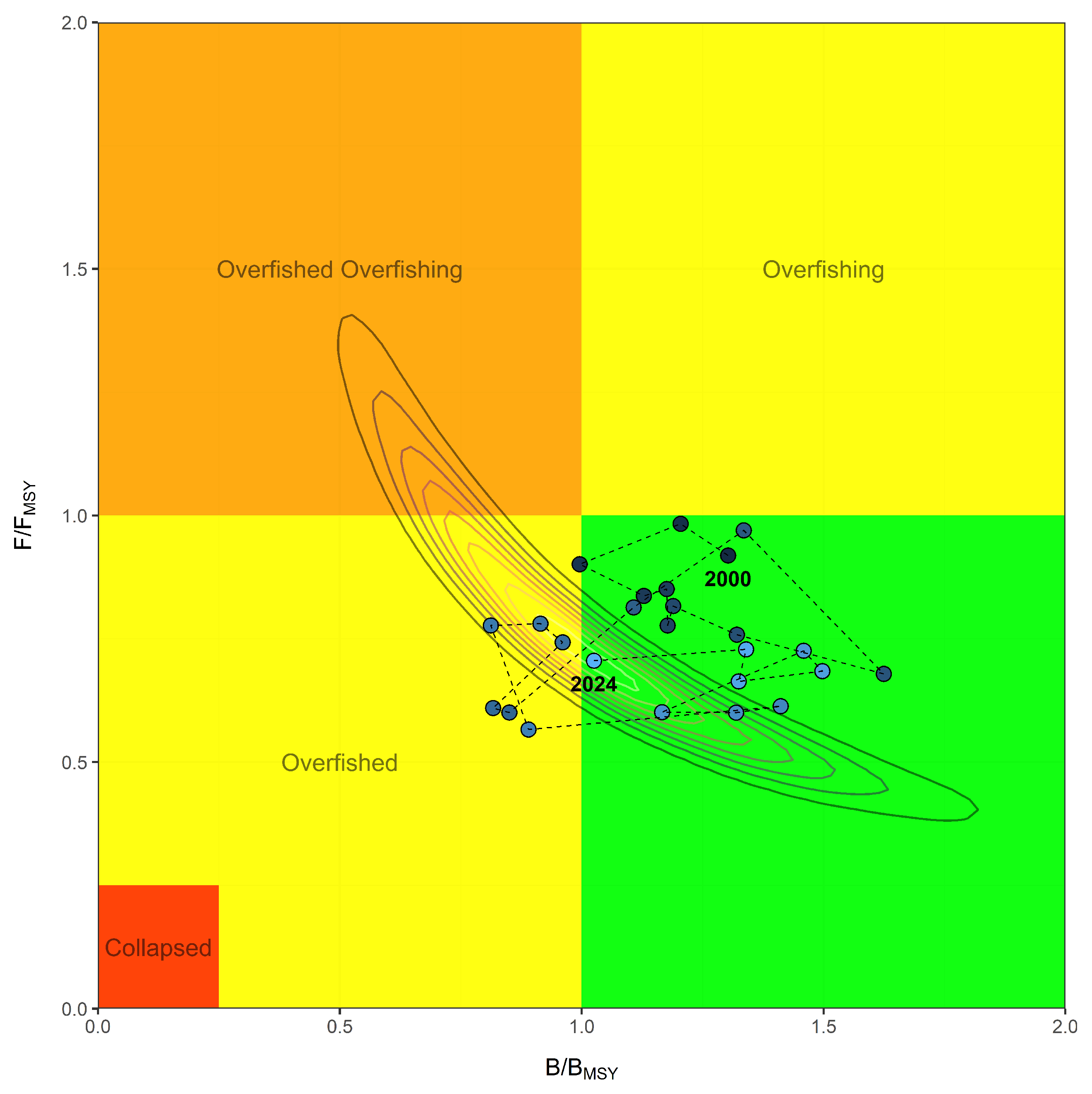Reconstruction of Recreational Catch and Multi-Fisheries Stock Assessment of Hairtail (Trichiurus lepturus) in Korean Waters Under a Data-Limited Situation
Abstract
1. Introduction
2. Materials and Methods
2.1. Data
2.1.1. Collecting Commercial Catch
2.1.2. Reconstruction of Recreational Catch
2.1.3. Standardizing CPUE Data for Multiple Fisheries
2.2. Stock Assessment Model for Multiple Fisheries
3. Results
3.1. Reconstructed Catch
3.2. Standardized Abundance Indices for Multiple Fisheries
3.3. Stock Assessment Results
3.3.1. Fitted Abundance Indices
3.3.2. Estimated Parameters and Reference Points
4. Discussion
5. Conclusions
Author Contributions
Funding
Institutional Review Board Statement
Informed Consent Statement
Data Availability Statement
Acknowledgments
Conflicts of Interest
Abbreviations
| CPUE | Catch Per Unit Effort |
| MGMS | MultiGear Mean Standardization |
| MSC | Mean Standardized Catch |
| SMSC | Summation of Mean Standardized Catch |
| EEZ | Exclusive Economic Zone |
| MSY | Maximum Sustainable Yield |
| HMC | Hamiltonian Monte Carlo |
Appendix A
| Listing A1. Stan code for Bayesian surplus production model |
|
References
- Statistics Korea. Fishery Production Statistics. 2025. Available online: https://www.kosis.kr/index/index.do (accessed on 18 January 2025).
- Nam, J.; Cho, H. Estimation of the Optimal Harvest and Stock Assessment of Hairtail Caught by Multiple Fisheries. Ocean. Polar Res. 2018, 40, 237–247. [Google Scholar] [CrossRef]
- Millar, R.B.; Meyer, R. Non-Linear State Space Modelling of Fisheries Biomass Dynamics by Using Metropolis-Hastings within-Gibbs Sampling. J. R. Stat. Soc. Ser. Appl. Stat. 2002, 49, 327–342. [Google Scholar] [CrossRef]
- Punt, A.E.; Szuwalski, C. How well can FMSY and BMSY be estimated using empirical measures of surplus production? Fish. Res. 2012, 134–136, 113–124. [Google Scholar] [CrossRef]
- Liang, C.; Xian, W.; Pauly, D. Assessments of 15 exploited fish stocks in Chinese, South Korean and Japanese waters using the CMSY and BSM methods. Front. Mar. Sci. 2020, 7, 623. [Google Scholar] [CrossRef]
- Hyun, S.Y.; Kim, K. An evaluation of estimability of parameters in the state-space non-linear logistic production model. Fish. Res. 2022, 245, 106135. [Google Scholar] [CrossRef]
- Pascoe, S.; Hutton, T.; Hoshino, E.; Sporcic, M.; Yamasaki, S.; Kompas, T. Effectiveness of harvest strategies in achieving multiple management objectives in a multispecies fishery. Aust. J. Agric. Resour. Econ. 2020, 64, 700–723. [Google Scholar] [CrossRef]
- Winker, H.; Carvalho, F.; Thorson, J.T.; Kell, L.T.; Parker, D.; Kapur, M.; Sharma, R.; Booth, A.J.; Kerwath, S.E. JABBA-Select: Incorporating life history and fisheries’ selectivity into surplus production models. Fish. Res. 2020, 222, 105355. [Google Scholar] [CrossRef]
- An, D.; Kim, K.; Kang, H.; Hyun, S.Y. A Bayesian State-space Production Assessment Model for Common Squid Todarodes pacificus Stock Caught by Multiple Fisheries in Korean Waters. Korean J. Fish. Aquat. Sci. 2021, 54, 769–781. [Google Scholar] [CrossRef]
- FAO. The State of World Fisheries and Aquaculture 2024; FAO: Rome, Italy, 2024; p. 264. [Google Scholar] [CrossRef]
- Zeller, D.; Pauly, D. Good news, bad news: Global fisheries discards are declining, but so are total catches. Fish Fish. 2005, 6, 156–159. [Google Scholar] [CrossRef]
- Zeller, D.; Booth, S.; Pakhomov, E.; Swartz, W.; Pauly, D. Arctic fisheries catches in Russia, USA, and Canada: Baselines for neglected ecosystems. Polar Biol. 2011, 34, 955–973. [Google Scholar] [CrossRef]
- Zeller, D.; Harper, S.; Zylich, K.; Pauly, D. Synthesis of underreported small-scale fisheries catch in Pacific island waters. Coral Reefs 2015, 34, 25–39. [Google Scholar] [CrossRef]
- Pauly, D.; Zeller, D. Catch reconstructions reveal that global marine fisheries catches are higher than reported and declining. Nat. Commun. 2016, 7, 10244. [Google Scholar] [CrossRef] [PubMed]
- Zeller, D.; Cashion, T.; Palomares, M.L.D.; Pauly, D. Global marine fisheries discards: A synthesis of reconstructed data. Fish Fish. 2018, 19, 30–39. [Google Scholar] [CrossRef]
- Tsui, G.; Derrick, B.; de Leon, S.; Parducho, V.; Popov, S.; Noël, S.L.; Relano, V.; Zhang, C.I. Countries of the northwest Pacific: Updating catch reconstructions to 2018. In Updating to 2018 the 1950–2010 Marine Catch Reconstructions of the Sea Around Us. Part II: The Americas and Asia-Pacific; Derrick, B., Khalfallah, M., Relano, V., Zeller, D., Pauly, D., Eds.; Fisheries Centre Research Report; Fisheries Centre, University of British Columbia: Vancouver, BC, USA, 2020; Volume 28, pp. 102–121. [Google Scholar]
- Shon, S.; Harper, S.; Zeller, D. Reconstruction of marine fisheries catches for the Republic of Korea (South Korea) from 1950–2010. Fish. Cent. Work. Pap. 2014, 2014, 1–13. [Google Scholar]
- Korea Law Information Center. Enforcement Decree of the Fishery Resources Management Act. 2025. Available online: https://www.law.go.kr/LSW/main.html (accessed on 20 January 2025).
- Kim, Y.H.; Yoo, J.T.; Lee, E.H.; OH, T.Y.; Lee, D.W. Age and Growth of Largehead Hairtail Trichiurus lepturus in the East China Sea. Korean J. Fish. Aquat. Sci. 2011, 44, 695–700. [Google Scholar] [CrossRef]
- Lee, S.J.; Han, S.H.; Kim, M.J. Occurrence of the Eggs of Hairtail, Trichiurus japonicus in the Coastal Waters of Jeju Island, Korea in Spring. J. Korean Soc. Fish. Technol. 2020, 56, 11–20. [Google Scholar] [CrossRef]
- Kim, D.G.; Seong, G.C.; Kang, D.Y.; Jin, S.; Soh, H.Y.; Baeck, G.W. Diet Composition and Feeding Strategy of Largehead Hairtail, Trichiurus japonicus in the South Sea of Korea. Korean J. Ichthyol. 2023, 35, 11–20. [Google Scholar] [CrossRef]
- Zhang, C.I.; Sohn, M.H. A Study on the Stock Assessment and Management Implications of the Hairtail, Trichiurus lepturus Linne in Korean Waters 2. Variations in Population Biomass of the Hairtail, Trichiurus lepturus Linne in Korean Waters. Korean J. Fish. Aquat. Sci. 1997, 30, 620–626. [Google Scholar]
- Gibson-Reinemer, D.K.; Ickes, B.S.; Chick, J.H. Development and assessment of a new method for combining catch per unit effort data from different fish sampling gears: Multigear mean standardization (MGMS). Can. J. Fish. Aquat. Sci. 2017, 74, 8–14. [Google Scholar] [CrossRef]
- Jackson, D.A.; Harvey, H.H. Qualitative and quantitative sampling of lake fish communities. Can. J. Fish. Aquat. Sci. 1997, 54, 2807–2813. [Google Scholar] [CrossRef]
- Hinch, S.G.; Collins, N.C.; Harvey, H.H. Relative Abundance of Littoral Zone Fishes: Biotic Interactions, Abiotic Factors, and Postglacial Colonization. Ecology 1991, 72, 1314–1324. [Google Scholar] [CrossRef]
- Meyer, R.; Millar, R.B. BUGS in Bayesian stock assessments. Can. J. Fish. Aquat. Sci. 1999, 56, 1078–1087. [Google Scholar] [CrossRef]
- Stan Development Team. RStan: The R Interface to Stan, R package version 2.26.24; Stan Development Team: Los Angeles, ON, USA, 2023. [Google Scholar]
- Froese, R.; Demirel, N.; Coro, G.; Kleisner, K.M.; Winker, H. Estimating fisheries reference points from catch and resilience. Fish Fish. 2017, 18, 506–526. [Google Scholar] [CrossRef]
- Gelman, A.; Carlin, J.; Stern, H.; Dunson, D.; Vehtari, A.; Rubin, D. Bayesian Data Analysis, 3rd ed.; Chapman & Hall/CRC Texts in Statistical Science; Taylor & Francis: Abingdon, UK, 2013. [Google Scholar]
- Pauly, D.; Zeller, D. Catch Reconstruction: Concepts, Methods, and Data Sources. 2015. Available online: https://www.seaaroundus.org/doc/Methods/CatchReconstructionMethod/Methods-Catch-tab-Sept-25-2015(1).pdf (accessed on 11 January 2025).
- Us, S.A. Sea Aroud Us: Catches by Taxon in the Waters of Korea (South). 2025. Available online: https://www.seaaroundus.org/data/#/eez/410?chart=catch-chart&dimension=taxon&measure=tonnage&limit=10 (accessed on 11 January 2025).
- Maunder, M.N.; Punt, A.E. Standardizing catch and effort data: A review of recent approaches. Fish. Res. 2004, 70, 141–159. [Google Scholar] [CrossRef]
- Chen, Y. Quality of fisheries data and uncertainty in stock assessment. Sci. Mar. 2003, 67, 75–87. [Google Scholar] [CrossRef]
- Monnahan, C.C.; Branch, T.A.; Thorson, J.T.; Stewart, I.J.; Szuwalski, C.S. Overcoming long Bayesian run times in integrated fisheries stock assessments. ICES J. Mar. Sci. 2019, 76, 1477–1488. Available online: http://arxiv.org/abs/https://academic.oup.com/icesjms/article-pdf/76/6/1477/31247349/fsz059.pdf (accessed on 15 January 2025). [CrossRef]








| Model | Catch Data | Abundance Data |
|---|---|---|
| Model 1 | Commercial [1] + Recreational (reconstructed) data | Multiple indices () |
| Model 2 | Commercial [1] + Recreational (reconstructed) data | Integrated index () |
| Model 3 | Commercial [1] data only | Multiple indices () |
| Model 4 | Commercial [1] data only | Integrated index () |
| Parameters | Model 1 | Model 2 | Model 3 | Model 4 |
|---|---|---|---|---|
| r | 0.538 (0.328–0.813) | 0.448 (0.275–0.680) | 0.528 (0.321–0.798) | 0.444 (0.272–0.668) |
| MSY (mt) | 66,446 (42,434–102,457) | 89,556 (50,806–154,062) | 64,633 (40,188–100,572) | 87,616 (49,211–152,595) |
| FMSY | 0.269 (0.164–0.407) | 0.224 (0.137–0.340) | 0.264 (0.160–0.399) | 0.222 (0.136–0.334) |
| last B/BMSY | 1.03 (0.48–1.82) | 1.36 (0.73–2.37) | 1.04 (0.47–1.89) | 1.37 (0.72–2.40) |
Disclaimer/Publisher’s Note: The statements, opinions and data contained in all publications are solely those of the individual author(s) and contributor(s) and not of MDPI and/or the editor(s). MDPI and/or the editor(s) disclaim responsibility for any injury to people or property resulting from any ideas, methods, instructions or products referred to in the content. |
© 2025 by the authors. Licensee MDPI, Basel, Switzerland. This article is an open access article distributed under the terms and conditions of the Creative Commons Attribution (CC BY) license (https://creativecommons.org/licenses/by/4.0/).
Share and Cite
Yoon, S.C.; Kim, M.-J.; Kang, H.; Choi, M.-J. Reconstruction of Recreational Catch and Multi-Fisheries Stock Assessment of Hairtail (Trichiurus lepturus) in Korean Waters Under a Data-Limited Situation. Fishes 2025, 10, 166. https://doi.org/10.3390/fishes10040166
Yoon SC, Kim M-J, Kang H, Choi M-J. Reconstruction of Recreational Catch and Multi-Fisheries Stock Assessment of Hairtail (Trichiurus lepturus) in Korean Waters Under a Data-Limited Situation. Fishes. 2025; 10(4):166. https://doi.org/10.3390/fishes10040166
Chicago/Turabian StyleYoon, Sang Chul, Moo-Jin Kim, Heejoong Kang, and Min-Je Choi. 2025. "Reconstruction of Recreational Catch and Multi-Fisheries Stock Assessment of Hairtail (Trichiurus lepturus) in Korean Waters Under a Data-Limited Situation" Fishes 10, no. 4: 166. https://doi.org/10.3390/fishes10040166
APA StyleYoon, S. C., Kim, M.-J., Kang, H., & Choi, M.-J. (2025). Reconstruction of Recreational Catch and Multi-Fisheries Stock Assessment of Hairtail (Trichiurus lepturus) in Korean Waters Under a Data-Limited Situation. Fishes, 10(4), 166. https://doi.org/10.3390/fishes10040166






